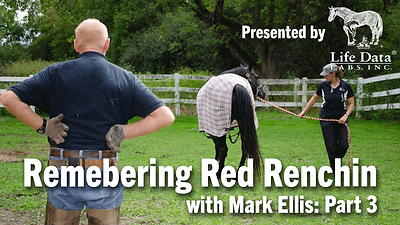Shoeing all horses the same way, also known as “program shoeing,” is a mistake in my view.
Every year, trainers, owners and agents pore over yearling catalogs to find bloodlines that they believe will succeed on the track. Bloodlines alone can create trends in yearlings that separate them from others. The yearling prospects are then scrutinized further by the buyers and agents who visit breeding farms and sale barns to look at the horses in person. These people have developed a definite sense for the qualities that they think will produce favorable results on the track.
Different people look for different qualities in a horse. The unpredictability of sales is a very good indication of this variance among buyers. Yes, of course there are a few yearlings every year that catch everybody’s eye. Most people will also agree that George Clooney and Angelina Jolie are beautiful people. The same type of popularity that creates multimillion dollar stars also makes for very expensive yearlings.
What many people are doing is to look for their favorite traits among the rest of the crop. It is those individual qualities which might propel that horse to the top in the view of each buyer. If we have gone to much trouble to find a potentially great horse based on individual traits, why then, would we shoe it like all other horses in the barn?
Certainly, there are some basic starting points. One example is starting all trotters out in half-rounds on front feet, and swedges or flats on the hind feet. This is a perfectly logical beginning point. Some naturally gaited horses don’t ever vary far from that basic shoeing. But, once training gets serious, the conformational and genetic traits that people seek out to distinguish one horse from another should create different shoeing needs.
At this point, I feel it isn’t fair to shoe them all the same as a matter of routine. Be it cross-firing shoes on the back of all the pacers, or heavy shoes on the front of all the trotters, I think it is a limiting strategy especially when I hear “that’s just how we shoe all our pacers” or “all our trotters,” but definitely more with pacers.
In my opinion, there is no way every horse can be its best wearing the same shoe as all other horses in the barn. Even the standard “fixes” are not universal. Lowering the outside branch of the offending hoof does not help all knee knockers. Raising the hoof angle does not always give relief to a soft tissue injury. In fact, sometimes it can hurt.
Program shoeing with corrective applications, such as trailers or grabs, adds stress on the legs of some horses that didn’t necessarily need it. If all trotters are shod with double trailers and caulks and all pacers shod with half-swedge and trailers, there will certainly be fewer instances of scalping and cross-firing. Many horses, however, will suffer for it.
A great shoeing package is only great for the horse that it suits. A great movie is only four-star rated from the people who enjoyed it. If all the horses in a barn are shod alike via program shoeing, I am sure there will be a few that would like to change the channel.
Veteran Standardbred farrier Steve Stanley of Lexington, Ky., authors a monthly column for Hoof Beats, the official harness racing publication of the U.S. Trotting Association. The American Farriers Journal Editorial Advisory Board member offers plenty of practical advice that will be of special interest regardless of the type of horses that you work with. Click here to read more from Steve Stanley's Hoof Beats series.








Post a comment
Report Abusive Comment